Two of the many dance performances that the week in the wake of New Years Day.
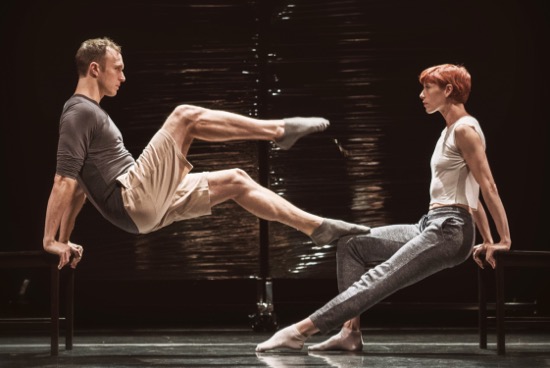
Ryan T. Smith and Wendy Rein of RAWdance in the opening piece of their Double Exposure. Photo: Andrew Weeks
Dance-loving Christians wishing to celebrate Epiphany (aka El Dia de los Tres Reyes Magos) would have done well to descend upon New York City, where the Association of Performing Arts Presenters was holding its annual conference (January 6 -10). “No room at the inn” might have been a prevailing message, and if you happened upon a stable full of angels, you would a) have been lucky to get in and b) have assumed this was a production by a company you’d never heard of.
Panels, speeches, workshops, performances, and networking galore. Every downtown and Brooklyn venue for dance was busy. The week was not for sissies, and I guess I count among them, because this year, I attended just two events, only one of which (Vicky Shick and Dancers) was familiar to me, and it was coincidental that I, a third-generation Californian, went to the Joyce Theater to see a program featuring RAWdance and CONTRA-TIEMPO—two of the companies grouped under the rubric of the American Dance Platform.
Ryan T. Smith and Wendy Rein met as undergraduates at Brown University and have been co-directing RAWdance, the San Francisco company they founded in 2004. Although there are nine additional dancers in the group, the pair brought to New York a slightly pared down version of the duet Double Exposure. This piece for the two of them could have been designed both to challenge them as performers and to give them a rest from being choreographers-in-charge. The short, welded-together works that they performed at the Joyce were provided by west-coast dancemakers Joe Goode, KT Nelson, Holly Johnston, Tahni Holt, Kate Wallich, David Roussève, Ann Carlson, and Amy Seiwart. During rest (or costume-change) breaks for them, we watched headshot videos of the two of them, side by side, talking about their work (interesting, if a bit contrived). In one of these sequences, they execute a very clever dialogue, arguing about a guy in song and rhythmic speech.
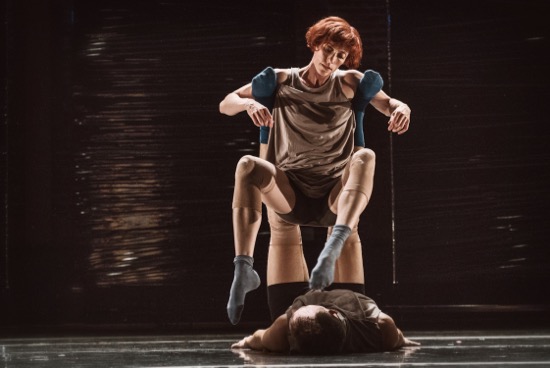
Wendy Rein and Ryan T. Smith in one of the dances in Double Exposure. Photo: Andrew Weeks
Smith and Rein are versatile, engaging performers, and most of the choreographers presented them as companionable equals. In their own opening number, sitting side by side on chairs and facing front, they perform various thoughtful maneuvers to deep-toned electronic sounds by Ohnuma. Yes, the choreography informs us, they are equable whether in synchrony or doing their own things; they can make clear physical connections to each other without fanfare or emotional dithering. Jim French provides excellent lighting that pinpoints them when necessary and colors the Joyce’s bare brick wall to suit.
Sometimes, over the course of the evening, they simply dance, showing how adroit they are and yet often concealing their polish. In other words, they’re accomplished, yet want us always to see them as thinking, feeling individuals, awkward when necessary. Nelson sets them dancing to Mozart piano music; the movement is expansive, yet nuanced, serene, even though it speeds up in order to enter the composer’s intricacies. Wallich edges their deliberate moves from individuality into unison while single, repeated piano notes play. Johnston’s duet folds tough push-and-pull maneuvers into an orderly competition with moments of tenderness, while Katharine Hawthorne’s dramatic music eggs them on (it’s as if Lord of the Rings were playing next door). As Holt’s piece begins, the two lie cuddled, then rise to investigate the many imaginative ways they can mesh, the only accompaniment their grunts, giggles, and heavy breathing (although the highly appropriate “I’ve Got You, Babe” did play at one point).
Ann Carlson’s duet is more enigmatic. Smith and Rein begin slumped in their chairs. And there’s a third chair, empty, some distance away. For sure they’re weary; they cough, they hunker down. Perhaps they’ve lost something or someone; maybe they’re their own grandparents. However, the music (Johnny Goss’s guitar) lightens and so do they. As the light slowly fades, they’re standing on their chairs.
Both Goode and Roussève’s works use text. Goode construed his as a prelude, although it comes just after Smith and Rein’s opening duet. In it, the two gesture and dance and talk, as if their job were to introduce the rest of the program. They mentions Goode’s views on the process of making a two-minute dance and talk about each other—Brian loves tv, Wendy makes excellent pie crust, etc., but after they moves the stools out of the way, she runs at him and he lifts her high. Interestingly, in the ensuing filmed conversation, in addition to pondering the possible connection between “raw” dance and raw sex, Rein muses on how talking and dancing may cancel each other out. That’s probably why I can’t remember much about the movement in Goode’s piece. We’re used to reading words more easily than we read movement.
Roussève is the one doing the talking in his piece, and some of what his recorded voice says alludes to the racist violence exemplified by Cari Ann Shim Sham’s projected video clip of a police shooting (of Walter Scott in North Carolina I believe). He also keeps talking about hearing Aretha Franklin singing “Change Is Gonna Come” and what he didn’t at first understand about it and how much he loves and honors it now. Just listen and you’ll understand too:
https://www.youtube.com/watch?v=j44uRBAxf8g
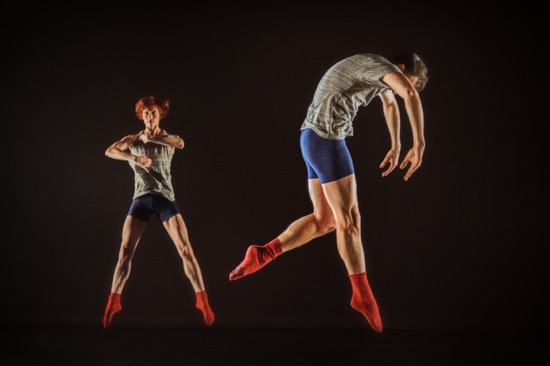
Wendy Rein and Ryan T. Smith take to the air in Double Exposure. Photo: Andrew Weeks
His slightly oblique message to dancers as citizens of the world is that they persist, resist, and be strong. The duet builds slowly in speed and intensity. It doesn’t take long for you to realize that Smith and Rein are repeating Roussève’s vigorous, rich, finely constructed phrase of dancing over and over and over. You recognize this gesture, this dip to the floor, and you see them persisting, resisting fatigue, and using every shred of strength until they’re gasping. Do I hear Roussève say “Is it enough?” or is it a voice in my head?
I have not been writing about these short dances in the order in which they occurred, but Smith and Rein have tailored the program of Double Exposure to bring out the contrast between styles, and end on an upbeat note: Amy Seiwert’s contribution. Cue the mirror ball, put the pair in a suit and tie and a fluffy dress, and go for it. Let us hear Kevin Johansen singing “Modern Love.” Rein and Smith know the right moves for the ballroom floor, but they make it plain that they’re (satirically) more enthusiastic than expert. She sits elegantly, but he drags her in that position to where he wants her. However, he gets down on all fours, and she sits astride him as if he’s her donkey. She’s also amenable to clumsy lifts and quite at home sitting on his shoulder as he wanders here and there.
Most of the choreographers, I’m guessing, know Rein and Smith’s work well, and that may have influenced their choices. Although the two intrepid artists do indeed transform themselves, you imagine the makers of these dances saying to themselves, “Hmm, let’s see what Wendy and Ryan can make of this.” And that feeling—as much as all the theatrical devices (the videos, changing costumes onstage, et al)—molds the evening into the highly enjoyable journey for two that it is.
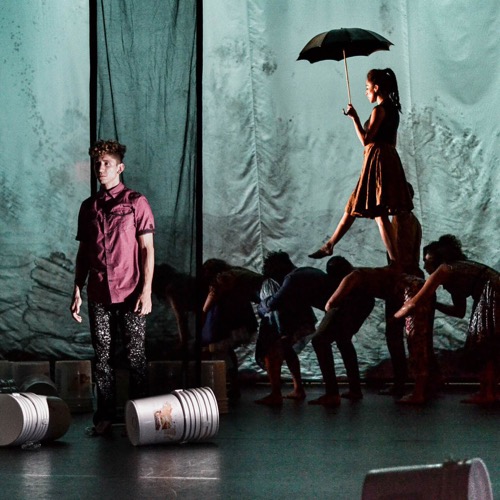
Agua Furiosa by CONTRA-TIEMPO director Ana Maria Alvarez. Francisco Herrejon stands (L); Jannet Galdamez walks across a moving bridge of dancers. Photo: Steve Wylie
Ana Maria Alvarez, the director-choreographer of CONTRA-TIEMPO, has big ideas about the world and what dance can bring to it. Watching the company perform her Agua Furiosa, I’m impressed by the risks she takes and by the intensity and deep-hearted strength that the nine performers bring to it. The movement mingles aspects of Afro-Cuban, salsa, hip-hop, and an earthy, flung-out form of contemporary dance that can accommodate to the emotions that impel it. Their bodies ripple, their feet tread rhythmically, their legs fly into the air.
If I tell you that elements drawn from Shakespeare’s The Tempest thread through the piece and mate with environmental issues to do with water, and with slavery, racial prejudice, and (according to the program, the performers’ “personal narratives”), you still may not fully understand what Agua Furiosa looks and feels like. Nor might you easily link text by such “ancestral wordsmiths/collaborators” as Chief Si’ahi, Audre Lorde, Sojourner Truth, and Shakespeare, as well as by Alvarez, company member Samad Raheem Guerra, and those who provided the music (Pyeng Threadgill for the opening and closing sections, d. Sabela grimes for everything else).Would you have known without going online for a quick dose of research, that Shakespeare’s Caliban is represented at different times by different members of the cast?
Even though dramaturge Michael John Garcés has assisted Alvarez, the piece is a kind of glorious mess. They have clearly pondered its structure and how it delivers its ideas, but the impression you get is of those ideas tumbling together to create images of constraint, oppression, freedom, daring, and social awareness.
It’s only afterward that I squirm around in my mind and conflate the plot-inciting storm of The Tempest with both our contemporary squandering of water and (possibly) the Middle Passage that transported slaves from Africa to America. And I think about Caliban’s plight: slave to Prospero, but son of the witch Sycorax (not in the play), who, banished to that distant island, created her own kingdom and enslaved others.
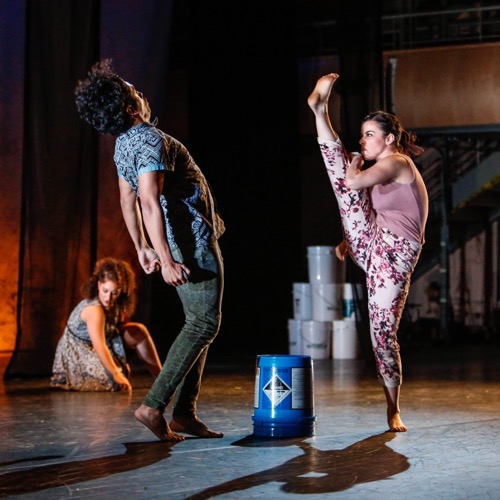
(L ro R): Bianca Medina, Christopher Cuenza, and Diana Toledo of CONTR-TIEMPO in Agua Furiosa. Photo: Stve Wylie
The visions that Alvarez creates are memorable. Electra Weston descends an aisle, resplendent in a headdress and a shimmering gown with a long train. Intermittently, she sings powerfully and talks fiercely; the program identifies her as “Ella,” a kind of avatar of Sycorax. The stage that she and the others enter is backed by a mysterious, misty image of an island. A wall of white buckets sits in front of it, and two narrow black veils hang, one behind the other, center stage. One of these veils soon falls to great effect, like a dissolving cloud, while the music and flashes of light conjure up a tempest (lighting by Masha Tsimring and Tuce Yasak, set and props by Madeleine Maloy and Alvaro Renteria).
The gorgeous Weston has a follower, much smaller than she (servant? daughter? Shakespeare’s Miranda?); Weston leaves off whipping one arm, as if summoning up the tempest, in order to caress the cheek of this woman (Jannet Galdamez). “Every sound is sacred to us,” Weston says, as the other others who’ve followed her to the stage roll and crawl around, suggesting both waves and sea creatures. Another woman (Isis Avalos) also emerges as a leader—she’s the one at the front of a phalanx that travels across the stage, and it’s she one who climbs a small hill of buckets and raises her arms triumphantly, as if to urge the others on. A few moments after she stands on her head, Weston announces that “the spell is broken.”
Water appears in both fantastic ways—the backdrop seems to ripple—and others more mundane. A large stash of water bottles is tossed onto the stage. The dancers grab them and swig. But they’re also careless, wasteful, and Francisco Herrejon, with two buckets attached to his belt, ranges about, catlike, collecting bottles, and taking them offstage. The wall of buckets itself is toppled, and, later, in a very short time, rebuilt. In what could be a children’s game or a ritual, the performers upend buckets, place them in a ring, and dance around them, faster and faster.
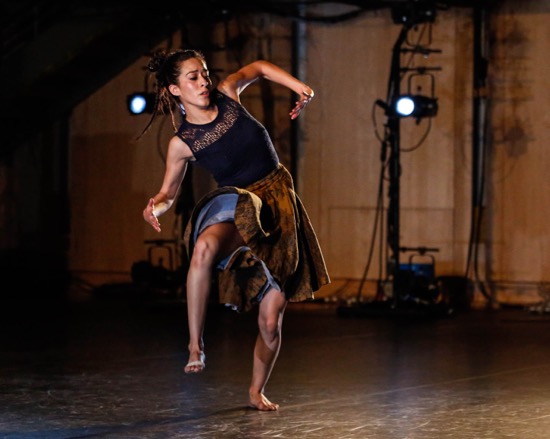
Jannet Galdamez of CONTRA-TIEMPO in Agua Furiosa by Ana Maria Alvarez. Photo: Steve Wylie
Some water is spilled onto the stage, and in the spreading puddle, while others huddle behind umbrellas, Guerra dances. I thought I heard Weston mention the “Caliban in you.” I can accept that, as well as the many-Calibans notion. However, to me, it was Guerra who, bare-chested and wearing red tights, embodied Caliban most memorably. Tense and hunched over, he makes his entire body tremble and shake. Slipping in the water, he can seem misshapen, oppressed by a force beyond his control.
So we spectators are processing images of waste, environmental stress, and human struggle amid a jungle of sights and sounds, out of which heroes may emerge. The dancers, costumed by Rosalida Medina, (Bianca Golden, Christopher Cuenza, Bianca Medina, and Diana Toledo, in addition to those already mentioned) are all powerfully invested in Agua Furiosa. They dance as if by doing so they might save the planet. Wish them luck.

It was refreshing to view the work of these artists from the other coast and, as always, so rewarding to revisit the
performance with you. Happy New Year!